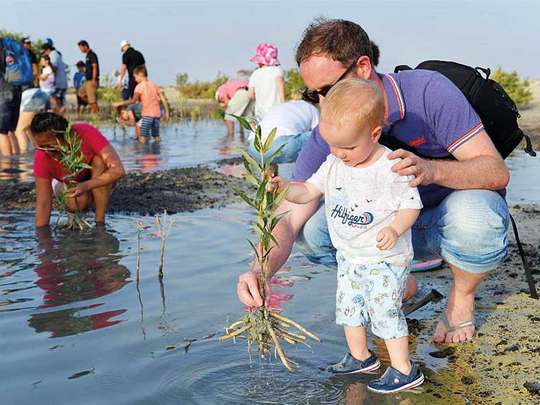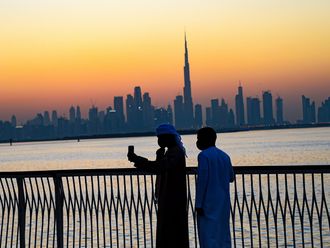
Dubai: The Jebel Ali Wetland Sanctuary in Dubai has been added to the Ramsar List of Wetlands of International Importance, making it the eighth protected wetland in the country, it was announced on Sunday.
The announcement of this latest addition to the Ramsar list was made on the sidelines of the last day of the 13th edition of the Ramsar conference held in Dubai.
The conference saw the gathering of more than 1,000 delegates from around the world.
Dr Thani Ahmad Al Zeyoudi, Minister of Climate Change and Environment, Engr. Dawood Abdul Rahman Al Hajiri, Director-General of Dubai Municipality, and Martha Rojas Urrego, Secretary-General of Ramsar, made the announcement on Monday.
The Jebel Ali Wildlife Sanctuary is also where the Ghantoot Marine Reserve is located.
It is a coastal and marine wetland that has coral reefs, mangroves, shallow lagoons, seagrass beds, oysterbeds, and sandy shorelines that is home to more than 500 marine species such as the critically endangered hawksbill turtle, the endangered mottled eagle ray, and green turtle.
Once a territory is included in the List of Wetlands of International Importance, it acquires a new national and international status because of its significant value not only to the country where it is located but ‘for humanity as a whole’.
Currently, there are more than 2,200 Ramsar sites worldwide, spanning more than 2.1 million km.
In the UAE, the other Ramsar sites cover a total area of almost 37,000 hectares.
These are the Wadi Wurayah National Park in Fujairah, the Mangrove and Al Hafeya Protected Area in Khor Kalba and Sir Bu Nair Island Protected Area in Sharjah, the Ghantoot Marine Reserve and Ras Al Khor Wildlife Sanctuary in Dubai, the Al Wathba Wetland Reserve and Bul Sayeef in Abu Dhabi, and Al Zora Protected Area in Ajman.
What is a Ramsar site
A Ramsar Site is a wetland site designated to be of international importance under the Ramsar Convention. The Convention on Wetlands, known as the Ramsar Convention, is an inter-governmental environmental treaty established in 1971 by UNESCO, and come into force in 1975.
2,200 Ramsar sites
Currently, there are more than 2,200 Ramsar sites worldwide, spanning more than 2.1 million km.
In the UAE, the other Ramsar sites cover a total area of almost 37,000 hectares.
These are:
■ Wadi Wurayah National Park in Fujairah
■ Mangrove and Al Hafeya Protected Area in Khor Kalba and Sir Bu Nair Island Protected Area in Sharjah
■ Ras Al Khor Wildlife Sanctuary in Dubai,
■ Al Wathba Wetland Reserve and Bul Sayeef in Abu Dhabi, and
■ Al Zora Protected Area in Ajman
What is the Jebel Ali Wetland Sanctuary?
It is a 2,002-hectare wetland located between the Palm Jebel Ali and up to the Dubai-Abu Dhabi border to the South West of Dubai.
Why is it important and what habitats can be found there?
The Jebel Ali Wetland Sanctuary provides shelter, feeding and nursery ground to a vast assemblage and diversity of endemic, threatened and migratory marine species.
Dubai Municipality in 2017 identified five main marine habitats of conservation interest:
1) Extensive areas of seagrass beds that serve as an important fish nursery, feeding grounds for green turtles and dugongs. (Approximately 7,000km2 of seagrass habitat as of 2012)
2) Breeding ground for hawksbill turtles on the sandy beaches at Ghantoot;
3) Small dense patches of hard coral communities dominated by sensitive table corals
4) Mixed communities containing diverse and seasonal brown macro-algae populations and sparse but numerous colonies of poritid and faviid hard corals;
5) Rich communities of fishes associated with high relief hard bottom habitat found at natural coral reefs and coral colonised breakwaters.
What flora and fauna can be found there?
■ The sanctuary is home to 539 species of marine fauna and flora.
■ A total of 34 species of corals are recorded in Ghantoot, of which 40 per cent are threatened, like the endemic species Acropora arabensis.
■ Some 124 birds, 34 corals and 147 fish and shark species have been recorded in the area.
■ Mammals: Dugong (Dugong dugon) and Indo-Pacific humpback dolphin (Sousa chinensis)
■ Fish: Orange-spotted grouper (Epinephelus coioides)
■ Shark species: Arabian carpet shark (Chiloscyllium arabicum), Whale shark (Chiloscyllium arabicum), Black-tipped reef shark (Carcharhinus melanopterus)
■ Reptiles: critically-endangered hawksbill turtle (Eretmochelys imbricata) in the UAE and the only one in Dubai Emirate use it as a breeding site;
■ 2 other threatened species of marine reptiles, Green turtle (Chelonas mydas) and Hawksbill turtle (Eretmochelys imbricata), both species are using the area as a feeding ground.
Is it open to the public?
Yes it is. But since it is a wetland, there are no facilities as such for a long-term stay. People can visit to see the area. Dubai Municipality is planning to make it more eco-tourism friendly in the coming months.
- Source: Ramsar, Dubai Municipality












